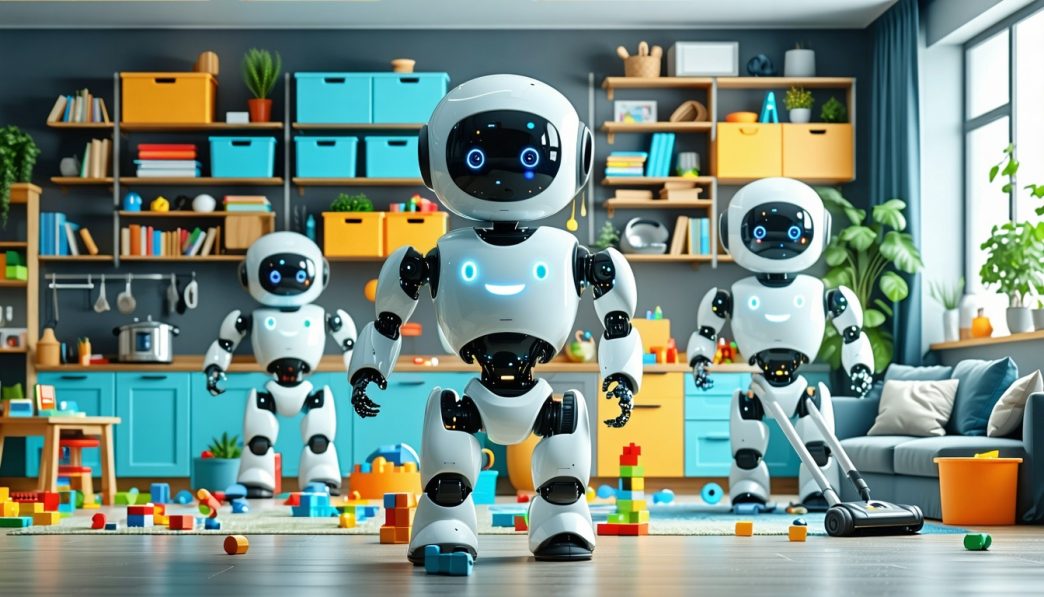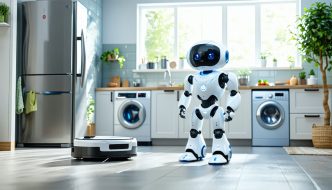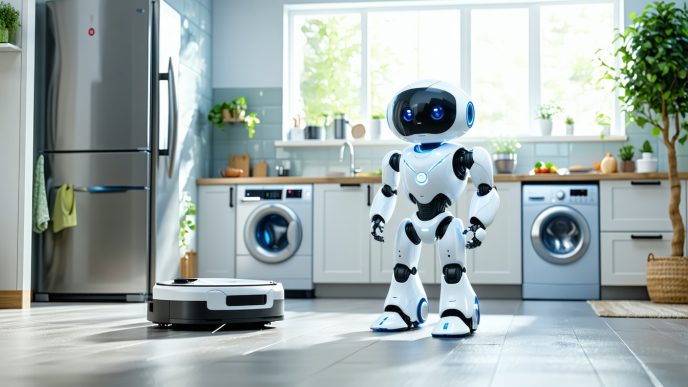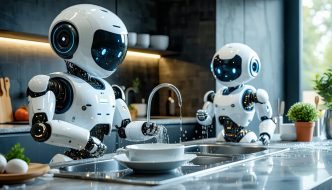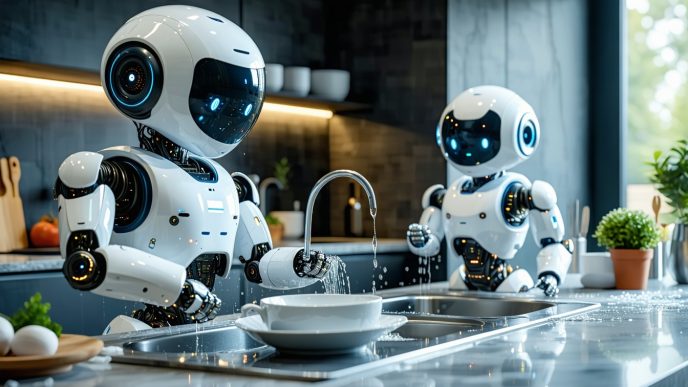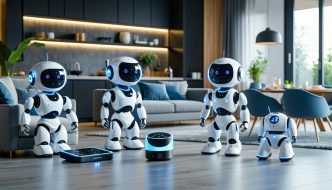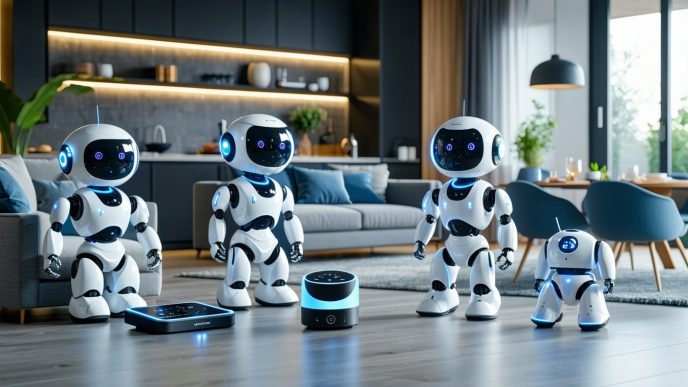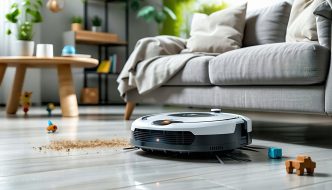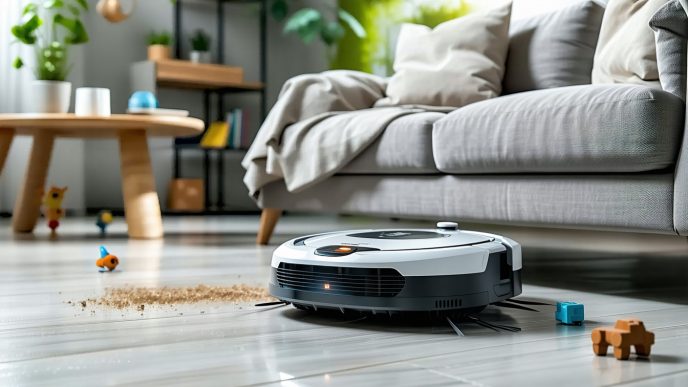The Rise of Home Robots
The integration of robots into household tasks has transformed how families and busy professionals manage their home environments. As technology advances, home robots have evolved significantly, making life easier and tidier.
Evolution of Robotics in Household Tasks
Household robotics has come a long way since its inception. Early automation attempts focused primarily on basic cleaning tasks. Over time, innovations have brought forth intelligent devices that can perform a variety of functions. Today’s robots can not only vacuum but also mop, manage laundry, and even assist in preparing meals.
| Year | Significant Development |
|---|---|
| 1996 | Introduction of the first robotic vacuum cleaner |
| 2010 | Launch of smart home devices that integrate with household robots |
| 2015 | Advancements in AI for improved navigation and task efficiency |
| 2023 | Increasing capabilities in multi-tasking and coordination with smart home systems |
These developments point to a future where robots are indispensable for everyday chores, enhancing efficiency and convenience within the home.
Benefits of Integrating Robots in Home Organization
The use of robots for organizing and tidying can drastically simplify daily living. Families and homeowners benefit from reduced workloads and saved time, allowing them to focus on more meaningful activities.
Key Benefits
- Time-Saving: Robots minimize the time spent on repetitive tasks, enabling individuals to reclaim hours in their day.
- Consistency: Robots provide consistent results in cleaning and organizing, ensuring that tasks are completed to a high standard every time.
- Energy Efficiency: Many robots are designed to operate with minimal energy usage, contributing to overall household efficiency.
- Smart Integration: With connected devices, many household robots can work seamlessly with smart home systems, enhancing user experience.
For more on how robots assist with specific tasks, explore our articles on household task robots, robots for cleaning floors, and robots for laundry assistance. Each of these robots plays a unique role in ensuring a more organized and tidy home.
Robotic Vacuum Cleaners
Robotic vacuum cleaners have revolutionized the way individuals maintain cleanliness in their homes. These autonomous devices operate independently, providing families and busy professionals with a solution to save time and reduce workload.
How Robotic Vacuum Cleaners Work
Robotic vacuum cleaners utilize advanced navigation technology, enabling them to clean floors efficiently. Most models are equipped with sensors that detect obstacles, allowing them to maneuver around furniture and avoid falls down stairs. They combine suction power with brushes that agitate dirt and debris, ensuring a thorough clean.
Here’s a breakdown of how these vacuums typically function:
| Component | Function |
|---|---|
| Sensors | Detect obstacles and navigate spaces |
| Brushes | Agitate dirt and debris for effective cleaning |
| Suction | Collect dirt, pet hair, and dust particles |
| Battery | Provides power for autonomous cleaning tasks |
| Charging Dock | Recharges the vacuum when not in use |
With programmable features, robotic vacuums can be scheduled to clean at specific times, making them an efficient choice for maintaining tidy homes. For more details on scheduling tasks for these devices, visit our article on scheduling tasks for household robots.
Features that Aid in Organizing and Tidying
In addition to basic cleaning functions, robotic vacuum cleaners come with various features that enhance their ability to facilitate organization and tidiness in living spaces.
-
Virtual Boundaries: Many models allow users to set virtual boundaries using magnetic strips or electronic mapping. This feature limits areas the robot cleans, ensuring that it focuses on specific rooms or zones on demand.
-
Automatic Dirt Disposal: Some advanced models include an automatic dirt disposal system, where the vacuum returns to its dock, emptying its dust bin into a larger container. This reduces the frequency of manual emptying.
-
Smart Home Integration: Robotic vacuum cleaners can connect with smart home systems, allowing for voice control and integration with other automated tasks. For insights on how these robots work within smart home ecosystems, explore our article on household robots working with smart homes.
-
Scheduled Cleanings: Users can set their robotic vacuums to clean at specific intervals, ensuring their space remains organized without manual intervention. Regular cleaning helps in maintaining a clutter-free environment.
-
Multi-Surface Capability: These devices can navigate different flooring types, such as carpets, hardwood, and tile, ensuring that every area of the home gets the attention it needs.
By integrating robotic vacuum cleaners into daily routines, households can experience a significant reduction in cleaning time, freeing up more hours for family and personal activities. They provide practical solutions that align well with the needs of busy families and individuals looking to enhance their living environments. For information on other robotic solutions, check out our articles on robots for cleaning floors or robots for laundry assistance.
Home Assistant Robots
Home assistant robots are designed to make daily life more manageable by assisting with various household tasks. These advanced machines enhance efficiency and organization within the home environment.
Functions of Home Assistant Robots
Home assistant robots come equipped with multiple functions that cater to various household needs. Some common functionalities include:
| Function | Description |
|---|---|
| Scheduling | They can autonomously schedule cleaning tasks and other household activities. For more information on automation, check our article on scheduling tasks for household robots. |
| Home Monitoring | These robots often have cameras and sensors to monitor activities within the home, ensuring security and peace of mind. |
| Communication | They can interact with family members or inform users about their day, upcoming appointments, or reminders. |
| Integration | Many home assistant robots can connect to existing smart home systems, allowing them to control lights, thermostats, and other devices. Refer to our article on household robots working with smart homes for details. |
These features make home assistant robots valuable tools for improving daily living and reducing workloads.
How Home Assistant Robots Facilitate Home Organization
Home assistant robots play a significant role in home organization by automating various tasks. Their ability to streamline daily activities contributes to a neater home environment.
| Benefit | Explanation |
|---|---|
| Time Saving | By delegating tasks to robots, individuals can focus on more important responsibilities, thereby saving time. |
| Consistency | These robots perform tasks regularly and consistently, ensuring that cleaning and organization are maintained. |
| Multi-Tasking Capabilities | Home assistant robots can handle various tasks simultaneously, such as reminding users of chores while cleaning autonomously. |
| Alerts and Notifications | They provide timely alerts related to household chores, preventing clutter and disorganization. |
Home assistant robots effectively contribute to a more organized living space while also supporting other robots geared towards cleaning floors, laundry assistance, dishwashing and kitchen cleaning, and gardening and yard work. With these technological advancements, families and busy professionals can experience enhanced convenience in managing their homes.
Robotic Mops
The introduction of robotic mops has revolutionized the way families and busy professionals manage floor cleaning. These devices supplement manual cleaning efforts, making them a significant part of robots assisting with organizing and tidying in modern homes.
Advantages of Robotic Mops
Robotic mops offer a range of advantages that enhance their appeal for households looking to maintain their living spaces effortlessly. Some key benefits include:
| Advantage | Description |
|---|---|
| Time-Saving | Robotic mops operate autonomously, allowing users to focus on other tasks while they clean. |
| Efficiency | Many models feature advanced navigation systems, ensuring thorough coverage of floor surfaces without missing spots. |
| Consistency | Regular use of robotic mops helps maintain cleanliness, reducing the buildup of dirt and grime over time. |
| Multi-Surface Cleaning | Many robotic mops can handle various surfaces, including tile, hardwood, and laminate, making them versatile for different areas of the home. |
| Low Maintenance | These devices typically require minimal maintenance, with easy-to-change cleaning pads and simple controls for operation. |
Contribution of Robotic Mops to Home Tidying
Robotic mops play a significant role in keeping homes orderly. Their ability to regularly clean floors contributes to tidiness in multiple ways:
-
Routine Cleaning: Robotic mops can be scheduled to operate at specific times via smartphone apps, ensuring that cleaning occurs regularly without additional effort.
-
Spot Cleaning: Many robotic mops have a spot-cleaning function, allowing them to focus on particularly dirty areas, which makes them effective for addressing spills and messes immediately.
-
Preserving Air Quality: By regularly cleaning floors, robotic mops help reduce dust and allergens, contributing to a healthier home environment.
-
Integration with Other Devices: Robotic mops can often be integrated into broader smart home systems. This means they can work in concert with other household task robots, creating a comprehensive cleaning schedule. Refer to our article on household robots working with smart homes for more information.
-
Assisting Other Tasks: While robotic mops focus on flooring, their use frees up time for homeowners to address other cleaning tasks, such as laundry or kitchen duties. Explore our insights on robots for laundry assistance and robots for dishwashing and kitchen cleaning.
Robotic mops are a compelling choice for families and professionals alike, providing efficient cleaning solutions that enhance the organization and tidiness of homes. By taking on the task of mopping regularly, they allow residents to enjoy cleaner living spaces with less effort. For insights into how robotic mops fit into a broader cleaning strategy, consider also looking at robots specifically designed for floor cleaning, noted in our article on robots for cleaning floors.
Smart Closet Organizers
Overview of Smart Closet Organizers
Smart closet organizers are innovative solutions designed to assist with the efficient use of space and the organization of personal items. These systems incorporate technology to streamline how clothes, accessories, and shoes are stored and accessed. By integrating automation into storage solutions, smart closet organizers cater to various lifestyles, making them particularly appealing for busy families, homeowners, and professionals.
The typical smart closet organizer is equipped with features such as sensors, automated racks, and inventory management systems. By utilizing these features, these organizers help minimize clutter and can enhance the overall aesthetic of a home environment.
How Smart Closet Organizers Assist in Home Organization
Smart closet organizers provide several practical benefits that significantly aid in home organization. These systems can:
-
Maximize Space Efficiency: By efficiently utilizing vertical space, smart organizers help homeowners make the most of their closet dimensions, accommodating more items without feeling cramped.
-
Automate Inventory Tracking: Many smart organizers are capable of keeping track of the items stored within them. This function can alleviate the daily hassle of searching for lost items, as users can easily check what they own through an app or display.
-
Personalized Organization: With customizable settings, users can adapt the organization of their closets based on seasonal changes or personal preferences. This feature is particularly useful for managing wardrobes effectively.
-
Streamlined Access: Automated systems can retrieve items for users, particularly helpful for individuals with mobility challenges. They can save time and effort when selecting outfits or gathering items for various occasions.
-
Integration with Smart Homes: Smart closet organizers can be linked with other smart devices, providing a cohesive experience. This connection enhances convenience, as users can control their closets through voice commands or smart home apps, thus contributing to the larger trend of household robots working with smart homes.
Here is a comparison of features provided by typical smart closet organizers:
| Feature | Benefits |
|---|---|
| Space Optimization | Utilizes vertical space effectively |
| Inventory Management | Tracks and catalogs items |
| Customizable Layout | Adapts based on user preferences |
| Automated Retrieval | Fetches items for easier access |
| Smart Home Integration | Connects with other smart devices |
Smart closet organizers serve as valuable additions to modern households, particularly for those looking for robots assisting with organizing and tidying. These solutions elevate the organization of personal belongings and contribute to a more efficient living environment.
Future Prospects of Home Robotics
The future of home robotics is brimming with innovation and possibilities that promise to transform household tasks. As families, homeowners, busy professionals, and tech adopters increasingly seek solutions for time savings and workload reduction, new trends and technologies are emerging in the realm of robots that assist with organizing and tidying.
Emerging Trends in Household Robotics
A notable trend in household robotics is the integration of AI and machine learning capabilities. These advancements allow robots to learn from their environments and adapt their functions accordingly. For example, robotic vacuum cleaners can map homes more effectively, optimizing cleaning paths and improving efficiency.
In addition to AI technologies, collaboration among devices is becoming more prevalent. Home robots are increasingly designed to work together with other smart home devices, enhancing their functionality and providing a more seamless user experience. This interconnectedness facilitates better planning and management of household tasks, streamlining efforts in organization and tidying.
Here is a look at some emerging trends in household robotics:
| Trend | Description |
|---|---|
| AI and Machine Learning | Robots learn and adapt to optimize household tasks. |
| Interconnected Devices | Robots work together with smart home systems for efficiency. |
| Enhanced Sensors | Improved technology for detecting and avoiding obstacles. |
| Voice and App Control | Users can control robots through apps or voice commands. |
Potential Impact on Daily Living and Home Management
The integration of advanced robotics into everyday life will likely have significant implications for daily living and home management. By providing efficient assistance with cleaning, organizing, and other tasks, home robotics can free up valuable time for families and professionals. This time can then be redirected toward more meaningful activities, such as spending time with loved ones or pursuing hobbies.
Robots that can manage laundry and dishwashing tasks, for example, will not only ease the burden of household chores but also contribute to a more organized living space. This contributes to reduced stress and a more enjoyable home environment for families.
As home robotics continue to evolve, they will also play a pivotal role in supporting aging populations and individuals with disabilities. Robots designed for specific tasks, such as those for laundry assistance and kitchen cleaning, can empower individuals to maintain their independence while ensuring their living spaces remain orderly and clean.
With the ongoing advancements in technology and automation, households can anticipate a future where routines are more manageable thanks to robots for cleaning floors, laundry assistance, and even gardening tasks, all working in harmony within a smart home ecosystem. Explore more about the future of household automation and how it is shaping modern living.


